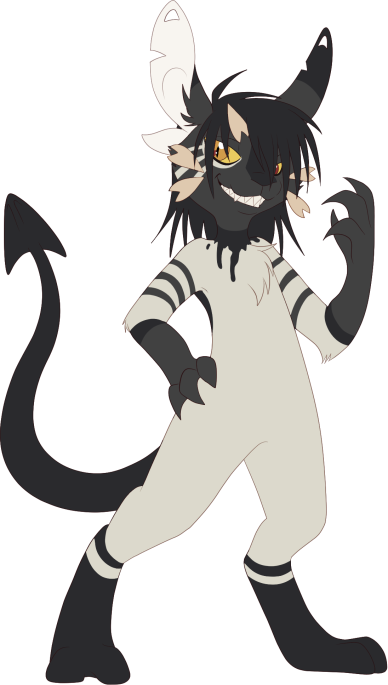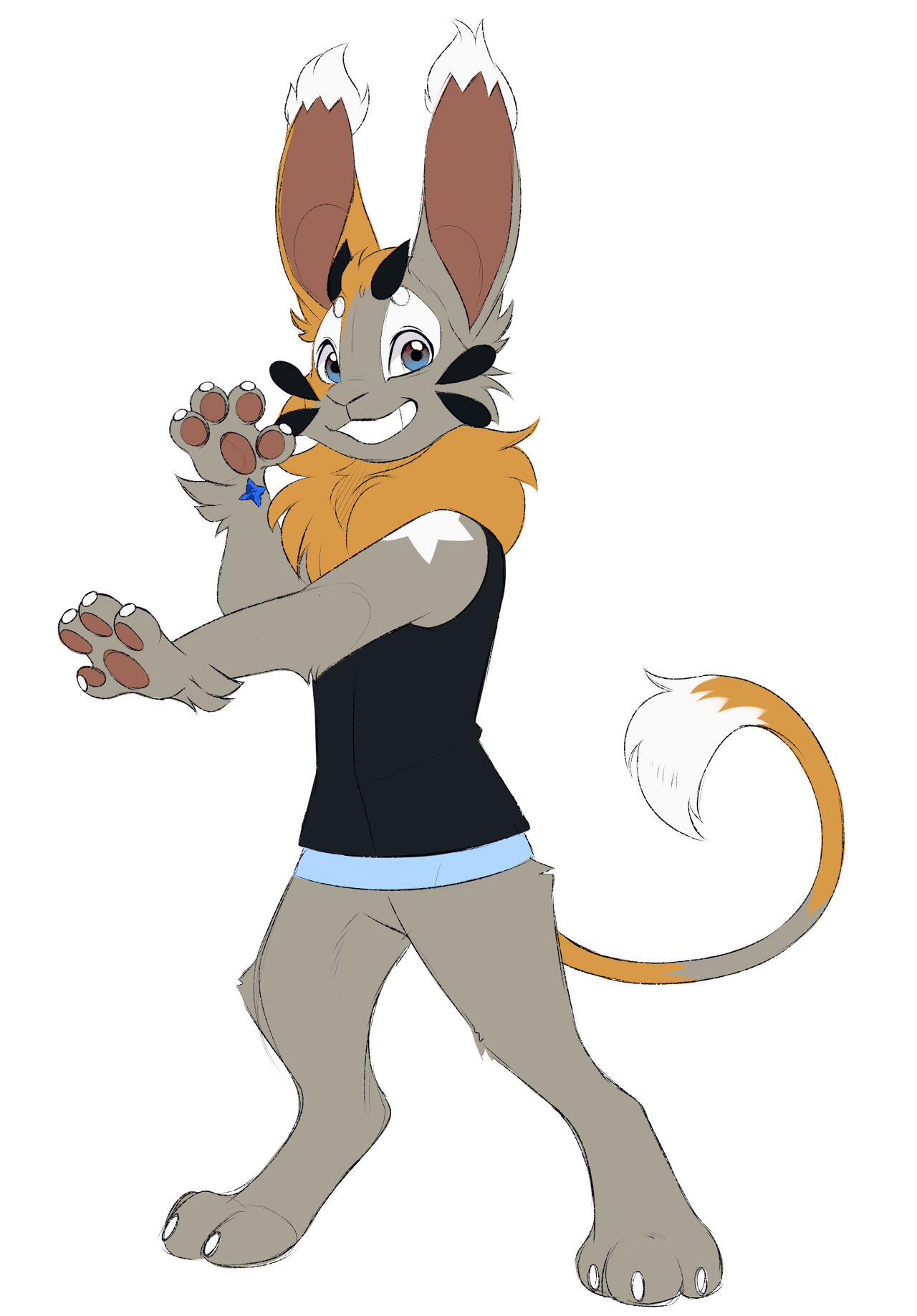Those who thrive in the wilderness...
Nyulop are a species known for their adaptability and hardiness, able to survive in a wide array of environments. It is believed that their alignments provide them great luck.
Their species name is pronounced "Nyew-lop," they are a mammalian species found all across Kladeon (and possibly beyond!). They are one of the two most prominent species, the other being Draken.
Their species name is the same in both singular and plural; one Nyulop, five Nyulop.
Species Origin
There is speculation that Nyulop originated somewhere in the Morray Mountains. Tribes and warrens of Nyulop have been found in the mountain range for thousands of years, and it is because of the climate that they developed into such resilient creatures. It is also used as an explanation for their exceptionally thick coats! There is, however, some contesting on this point. Some scholars believe Nyulop originated more south, citing their sizable ears and ability to adapt quickly to rapidly changing climates as examples of their desert heritage. Despite that, the majority still believes that the Nyulop species comes from more mountainous regions. Nowadays, their species spans the globe and can be found almost everywhere.
Species Basics
Nyulops are known to come in two variations: Lucky and Unlucky. These variations are based on both a physical and magical aspect. Physically, Lucky Nyulop have lighter coloured pelts, rounded "whiskers", three toed back feet and a rounded tongue. Alternatively, Unlucky Nyulop have traditionally darker coloured pelts, notched "whiskers", two toed back feet and forked tongues. When it comes to magic, Lucky Nyulop harness their charm to increase their own luckiness, while Unlucky harness their charm to decrease the luck of those around them. Both variants can live harmoniously due to the fact their charms cancel one another out.
Nyulop are characteristically peaceful creatures, living in groups called warrens, and thriving in a mixture of agrarian and gather lifestyle. They are omnivorous, eating a mixed diet of fruits, vegetables, grains and meats. They do enjoy dairy, although it isn't common in their cuisine. They work well in tandem and make excellent teammates. They are known for their excellent sense: heightened eyesight, hearing, and sense of smell. They're fast, able to walk on two feet and all fours, with varied builds and heights.
Eggs & Hatchlings


Baby Nyulop are, believe it or not, hatched! That's right, they come from eggs. It's rare for mammals to produce eggs, but not unheard of. Some even speculate that this is an adaptation, one which allows interspecies breeding. Hmm. Nyulop eggs need to be kept warm, and therefore are often held and coddled by both parents. They're not very large, about the size of a real-world goose egg, so infants are extremely tiny and fragile when born!
Infant Nyulop are born essentially blind and deaf, with their sense of sight and hearing taking a few weeks to fully develop, leaving them entirely dependent on their parents for care. Infants are also born "blank", meaning that they show no markings when first hatched, and only start developing them as their pelts grow in. The fur they're born with is extremely short, but velvety soft to the touch.
Similarly, their all important whiskers start off as small little oval-like shapes. As they mature and their pelts grow in, their whiskers take shape to make the baby more identifiable as Lucky or Unlucky. Both the change in their whiskers and the showing of markings takes approximately a month. During this time the infants remain small little chubby balls and squeaks.
The eggs are normally white or off-white with black flecks. It is believe this is to help camouflage them in wintry environments.
Kits
Young Nyulop are commonly referred to as "kits" (alternatively referred to as “nips” or "nippers" due to their tendency to be very nippy when young). They're small in stature, round, and pudgy. They are often quite fluffy, their pelts having grown out from infancy, and their true colours start to show. Their markings and other forms of physical identification begin to show. This usually occurs around 2-3 months of age.
Kits are curious and naturally inclined to explore. They desire to know their surroundings and everyone in it. This means that there is usually a designated adult or two watching over a collective of kits. This is made easier by the fact that warrens often assist in the raising of kits, meaning that an entire community will aid in the growth and development of the young. This is usually made easier by bringing the kits together for activities and playtime. It both helps strengthen a bond and encourage good social behaviour.
Kits are also the first stage at which they can begin to show unique changes known as Amelio Phenomena. This refers to the sudden physical change of a kit (and later, matured Nyulop). It is not seen as something otherworldly or negative, but rather something considered a blessing. It is usually viewed as something achieved by the individual by means of unlocking something within themselves. Casually it is referred to as an "AP". Sometimes you may overhear someone saying "Oh hey, they got hit by a new AP last night, that's so cool."
Matured Nyulop

A matured Nyulop stands quite a bit taller than their kit counterparts, with longer and more lithe bodies, and more pronounced digits on their paws. They have a more upright posture, but are still comfortable walking on all fours. As they mature, the Nyulop's body becomes tougher and more capable of physical endurance, making them best suited for running and evasiveness. Their senses also develop further and become more heightened.
Matured Nyulop also enter a stage at which they are able to start mastering or minoring their charms. As kits, their charms can sometimes be unpredictable, but matured Nyulop are able to better harness these abilities and focus them into controlled acts of magical prowess. They do so by following the teachings of The Four Elders. A matured Nyulop may attempt to fully master one of the four branches, or minor in two of them. This is entirely based on their individuality and preferences.
This stage of their life is also the one filled with the most variety when it comes to interactions. As they mature, Nyulop begin having romantic interests and pursuits, and will often find themselves attracted to one or more potential partners. Nyulop are predominantly monogamous, meaning they only take one partner at a time, and it is usually the case that they mate for life once they've found their perfect match. The process of searching for and courting potential mates is another story entirely.
Anatomy
There is a variety of basic head shapes to be found in the Nyulop species. Much like real-world rabbits, Nyulop come in a variety of statures, which means it's more than possible for individuals to have slightly different features. It is, however, important to remember not to stray too far from the examples shown above. Those three head types are the most common found in Nyulop.
Some Nyulop showcase more fur than others, and this is perfectly normal! You may choose to draw your Nyulop character(s) with or without excess fur on their elbows. Their upper bodies are known for being quite fluffy! Just be sure not to add excess fluff below their hips. Their legs tend not to be very fluffy.
It is of the utmost importance that you always remember to draw Nyulop whiskers facing the correct way. Forehead whiskers point towards the sky, cheek whiskers point inwards to the face. This has symbolic meaning in Nyulop culture: the forehead whiskers represent a higher power, pointing towards the heavens, showing a "closeness" to those long past; the cheek whiskers point inwards as if to represent a sense of self in connection to those higher beings.
- Whiskers are also not their eyebrows. They can move to match expressions, but Nyulop do have facial muscles that act more as eyebrows. It is also important for the whiskers to be drawn attached to the face, rather than hovering around it, because it's this sense of closeness that connects the Nyulop culture to the sentiment they have for their whiskers.
- Some variety in size is permitted, but please be mindful that the whiskers must be approximately the same size as shown in the example.
- It is important to remember that Nyulop have six (6) whiskers! It is believed that if Nyulop were to ever lose one or all of their whiskers they would break their connection to the higher beings, namely The Four Elders, and subsequently lose their charms!
The difference in Alignment
It is important to remember the four (4) key physical differences between Lucky and Unlucky Nyulop!

- Unlucky Nyulop have notched ears
- Unlucky Nyulop have notched whiskers
- Unlucky Nyulop have notched tongues
- Unlucky Nyulop have two-toed feet

- Lucky Nyulop have rounded ears
- Lucky Nyulop have rounded whiskers
- Lucky Nyulop have rounded tongues
- Lucky Nyulop have three-toed feet
──────────────────────────────────── ⋆☆⋆ ──────────────────────────────────────